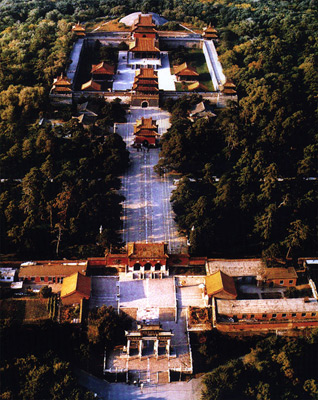Zhaoling Tomb is located in Beiling Park, the largest park in
Shenyang. It is the mausoleum of Huang Taiji (Emperor Taizong) of
the Qing Dynasty (1644-1911) and his queen Bo'erjijite. Huang Taiji
was the eighth son of Nurhachi, a great leader who established the
Later Jin State and laid the foundation of the Qing Dynasty. He was
an outstanding politician and strategist of Manchu, like his
father. As the tomb lies to the north of Shenyang City, it is
usually called Beiling (North Tomb). Its total area is 4,500,000
square meters (1,112 acres).
 |
Construction of the mausoleum began in 1643 and was finished
after eight years. Zhaoling Tomb, together with Fuling Tomb in
Shenyang and Yongling Tomb in Xinbin are called the Three
Mausoleums of the strategic pass (referring to the area between the
east of Shanhaiguan Pass and the west of Jiayuguan Pass). Zhaoling
is the largest and most magnificent. It is also one of the best
preserved imperial mausoleums of China. In March, 1982, it was
listed in the second group of Key Cultural Relics Units under the
State Protection by the State Council. The long history of Zhaoling
Tomb as well as its classical architecture attracts thousands of
visitors every year.
The layout of Zhaoling Tomb can be divided into three parts from
south to north by three buildings: the Horse Dismounting Tablet,
the Red Gate and the Square City. The first two parts are used for
worship and festivities, while the third part is the burial place
of the Emperor.
The first part is between the Horse Dismounting Tablet and the
Red Gate. On the Horse Dismounting Tablet, 'please dismount from
the horse here' is carved in the three languages of Manchu, Han and
Mongolia, to tell people that the frontage is the mausoleum of the
Emperor and they should dismount to show respect to Huang Taiji.
After the Horse Dismounting Tablet is the Divine Bridge which is
built over a moat. The moat and Longyeshan (Longye Moutain) at the
back of the tomb make up the so-call Feng Shui Bao Di (a valuable
land with a good geomantic omen). Visitors can then see the Cloud
Pillar (ornamental column) after walking over the bridge. The cloud
pillar is a special kind of construction of ancient China. It is
built in front of the mausoleum or palace to show that the emperor
is not obstinate and is willing to listen to others' advice. To the
north of the Cloud Pillar is the Stone Tablet. It is a standard
construction of Ming (1368-1644) and Qing (1644-1911) dynasties
commemorating the departed saint.
 |
?
The second part is between the Red Gate and the Square City.
Passing the Stone Tablet, visitors can see the Red Gate, which has
three gateways. During a festivity, the emperor walked through the
left one and the ministers used the right one. The middle gateway
led to the Divine Road which was prepared for the spirit of Huang
Taiji and his queen. Only those who carried sacrifices could pass
through the middle gate at that time. On both sides of the Divine
Road is another pair of Cloud Pillars. Following them, there are
six pairs of stone animals showing the strict distinction between
the different statuses in feudal society. Walking along the road,
we can see a stele of 50,000 kilograms (50 tons) built in a
pavilion. These were built by order of Emperor Kangxi (a great
emperor in Qing Dynasty) and the epigraph on the stele was also
written by him.
 |
The last part of Zhaoling Tomb is the main structure of the
mausoleum which was built on the flat with a floor area of 160,000
square meters (39.5 acres). It consists of the Square City, the
Crescent City, the Ming Pavilion and the Treasure Top. The most
palatial place in this area is the Longen Hall in Square City. Its
floor is covered with gold ore, which shines in the sunlight. It is
the so-called Jin Shi Pu Di (ground paved with gold). On the top of
the north gate of Square City is the Ming Pavilion which is the
tallest building in the park. In the Ming Pavilion, there is a
white marble stele 6 meters (19.7 feet) high. In the middle of the
stele is written the character Zhaoling in the three languages of
Manchu, Han and Mongolia. However after being struck many times by
lightning, its surface has degraded. Behind the Ming Pavilion, is
Crescent City - named because of its shape. Following Crescent
City, visitors can see Treasure Top. The essential part of the tomb
- the Underground Palace, which is the tomb of the Emperor and his
queen, is located under Treasure Top. Longyeshan which is a man
made hill is at the back of the Treasure Top.
Another characteristic of Zhaoling Tomb is its ancient pines,
which stretch for miles. There are more than 2,000 pines, most of
which are over 300 years old. The green pines form magnificent
scenery around the palatial palace. Amongst them, the Phoenix Pine,
the Spouse Pine and the Tortoise Pine stand out.
Travel tips:
Admission fee: 36 yuan
Opening hours:?8:30-17:00
Bus route: 10, 213, 217, 220, 231, 232, 242, 245, 605
(travelchinaguide.com )